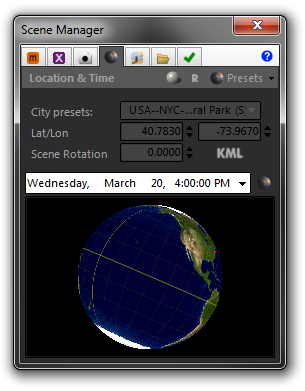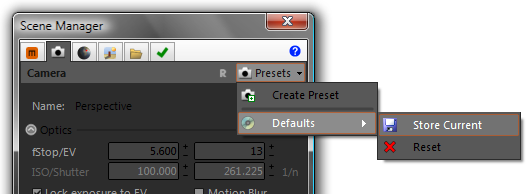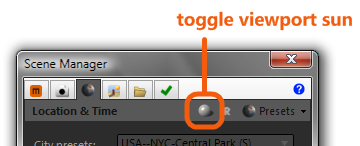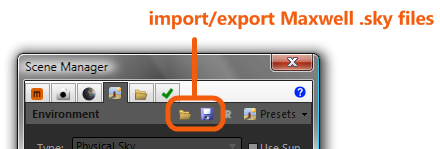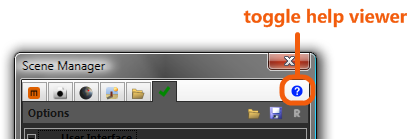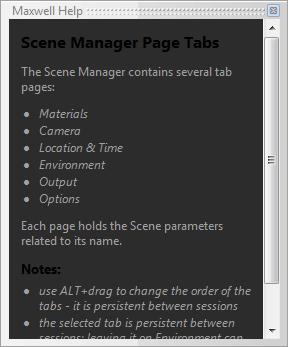Rhino 5 - Scene Manager
The process of exporting and rendering of MXS files with the Maxwell for Rhino plugin is managed using the Scene Manager window. To open the Scene Manager, either click the appropriate button in the plugin’s Tools toolbar, or click Maxwell > Plugin Windows > Scene Manager:
The Scene Manager has several tabs, each of which deals with a particular aspect of the Maxwell scene:
| Tab | Description |
|---|---|
| Materials | This tab contains the list of materials used in the current scene; these materials are saved with the document. New materials may be created from scratch, by using the plugin’s material Wizard, or by dragging MXM files into the list from the Database Manager’s MXM Browser page, or from Explorer. |
| Extensions | This tab contains a list of extensions (currently, Maxwell Grass, Sea, and Volumetric). Extensions may may be applied to geometry, using the right-click menu, to change how it is rendered. In some cases, an extension may modify the object's geometry, while in others, it may replace it entirely. |
| Camera | Contains parameters used to control the Maxwell camera. Each Rhino viewport gets its own camera, including Named Views. At MXS-export time, all Rhino views and Named Views will be exported, unless the Active camera only option is set in Scene Manager > Options > Export. |
| Location & Time | Contains parameters which control the scene’s location, time, and date. Time and date may be set interactively by dragging the SunView globe, which provides a Suns-eye view of the Earth. The scene’s location may be set explicitly using the Latitude and Longitude values, by choosing a city preset from the drop-down list, or by browsing for a .kml file. The Sun may be shown in the viewport by toggling-on the Show Sun in Viewport button in the toolbar. |
| Environment | Determines which render environment to use; the choices are: Sky Dome, Physical Sky, Image Based, or None. |
| Output | Contains parameters which control where the output files will be written, how the image will be rendered, and which export options to use. |
| Options | Contains various plugin user-Preferences which are used to determine various plugin behaviors. |
Scene Manager Tabs & Toolbar
The toolbar located below the Scene Manager’s tabs strip is context-sensitive; it holds slightly-different controls, depending on which tab page is currently being shown:
Most of the pages contain a ‘Reset’ button and ‘Presets’ drop-down. The Reset button simply sets all parameters in the current page back to default. Default means one of two things: the default settings used by the plugin as installed, or the user-defined default settings. The way you define your own defaults is to use the ‘Defaults’ item found at the bottom of the Presets menu:
Clicking ‘Store Current’ will set the current state of the page as your user-defined default, while clicking ‘Reset’ will return the factory settings. Similarly, clicking ‘Create Preset’ stores the current state of the page into a user-defined preset which may be recalled any time in the future. The materials page has no controls in the toolbar, while the Camera and Output pages have only the Reset button and Presets drop-down. The Location & Time page has, in addition to Reset and Presets, a toggle-button which enables the plugin’s viewport Sun display:
Toggling-on this button will also enable the Sun in the exported MXS file. However, since it is not always desirable to have the Sun enabled in the viewport, toggling this button off does not also disable the Sun in the exported MXS file; to turn the Sun off in the render, un-check the Use Sun checkbox in the Environment page.
The Environment page has two extra buttons which are used to import and export Maxwell .sky preset files, which hold all of the information required to define Maxwell’s atmosphere, location, date, and time:
The Options page, which does not have a Presets drop-down, adds two buttons to the toolbar which are used to import/export files used to define plugin color-schemes. These are simple .xml files, and they allow easy sharing of color schemes.
In addition to these functions, the Scene Manager’s tabs:
- Remember which tab was selected at the close of the last session.
- Can be re-ordered by holding down ALT and using drag/drop to move tabs.
Due to the auto-GMT feature of the Location & Time page’s SunView globe, it is recommended not to leave this page visible at shut-down; this is because each page is loaded on-demand and loading the Location & Time tab takes more time than the other lighter-weight tab pages.
Dynamic Help
The Scene Manager also has in its toolbar a button which toggles the visibility of the plugin’s real-time help viewer window:
When the help viewer is open, the cursor will change to a ‘help’ cursor whenever it is over an item which has help associated with it; left or right-clicking at this location will cause this help to be shown in the help viewer:
